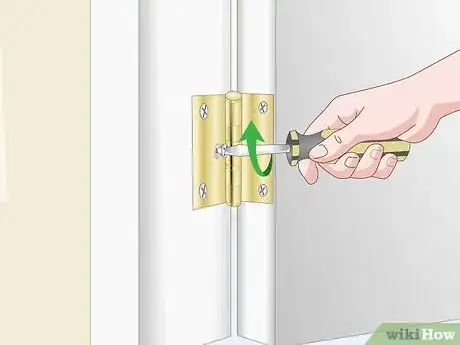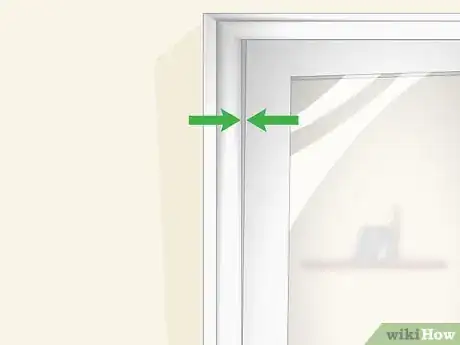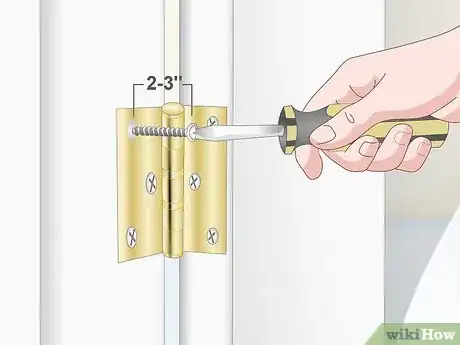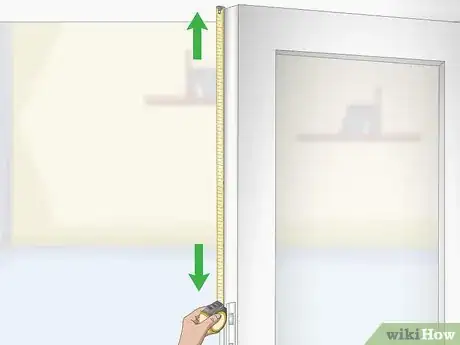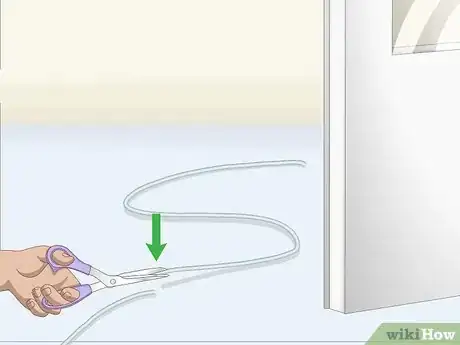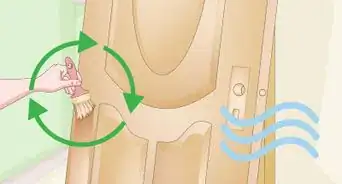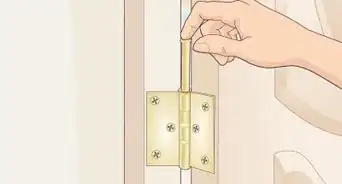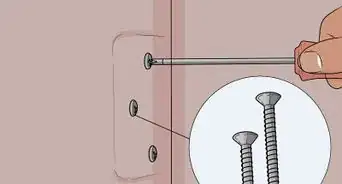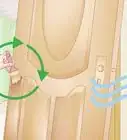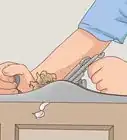This article was co-authored by Christopher Lanier and by wikiHow staff writer, Hunter Rising. Christopher Lanier is a handyman and the owner and operator of Watson & Company Handiworks, a handyman business in Austin, Texas. With over three years of experience, Christopher specializes in outdoor light installation, furniture assembly, TV mounting, and window treatment installation. Christopher holds a Bachelor’s degree in Business Administration from the University of Texas at Austin. Watson & Company Handiworks is rated as a Top Pro by Thumbtack.
There are 8 references cited in this article, which can be found at the bottom of the page.
This article has been viewed 64,411 times.
Over time, French doors will start to loosen in their frame and hang crooked, making it difficult to open or close. Luckily, leveling your doors is as easy as tightening or loosening your hinges until the doors are back in place. If you’ve made your adjustments to the hinges and you still feel a draft coming inside, you may need to add new weatherstripping on the inactive door to seal it. Once you’re finished with your adjustments, your French doors will open and close easily!
Steps
Adjusting Hinges on Sagging Doors
-
1Tighten all of the screws in each hinge with a screwdriver.[1] Over time, the screws on your hinges may come loose and cause your doors to sag. Open both of the French doors to expose the screws holding the hinges in place. Use the type of screwdriver that matches the heads on the hinge screws. Turn all of the screws on each side of the frame clockwise to tighten them and see if the doors are aligned again.[2]
- Don’t overtighten your screws since they could cause damage to the doors or the frame.
-
2Check that the distance between the doors is the same for the entire height. Close your doors and inspect the gaps between the doors. Use a measuring tape to find the distance between the 2 doors to see if it’s the same from top to bottom. If it is, then your door is level, but if the gap varies in size, your door is still sagging and you need to make further adjustments.[3]
- Many times, the active door you use most often will start to sag since it’s opened and closed more.
Advertisement -
3Adjust any positioning screws if your hinges have them. Positioning screws are usually in the center of your hinge plates and tightened with a hex wrench. If you need to move the active door closer to the door frame, rotate the positioning screw clockwise by a half-turn at a time. If you need to move the door out from the frame, then turn the screw counterclockwise. Check the distance between the doors and the frame to make sure they are all uniform in size.[4]
- If your door is sagging down and sticking at the top, then tighten the top and middle hinges. If it’s sticking at the bottom, then adjust the bottom hinge.
- Open and close the door while you work to see how your adjustments affect the door.[5]
Tip: Adjusting the hinges on your French doors can also fix a sticky latch if your door is difficult to open.
-
4Use longer screws if there are large gaps between the doors and frame. If your door still sags, the screws holding your hinges in place may not be long enough to reach the door jamb. Remove the screws on the hinge plate attached to the door frame and replace them with wood screws that are least 2–3 inches (5.1–7.6 cm) long. The longer screws will help support the weight of the doors better.[6]
- Only replace the screws in 1 hinge at a time so your door doesn’t fall out of the frame.
-
5Try shimming the hinges to level the door if screws don’t fix the gaps. Unscrew one of the hinges and remove it from your door and frame completely. Trace the outline of each hinge plate 3 times onto thin pieces of cardboard, like the kind you would find on a shoebox, and cut the shims out of the cardboard with a utility knife or a pair of scissors. Put 3 cardboard shims in each of the hinge’s mortises, which are the gaps in the frame and door where the hinges rest, and secure the hinge back in place.[7]
- Close your door after you put in the shims to check if you need to adjust any of the other hinges.
Sealing a Drafty Door
-
1Pull the old weatherstripping off of the French door before replacing it. The weatherstripping is usually located on the astragal, which is a long strip of vertical molding on the inactive door. Open the active door and locate the foam weather stripping on the astragal and peel it off of the door. If you have trouble peeling off the old weatherstripping, then use a paint scraper to remove it.[8]
- Interior French doors will not have weatherstripping, but exterior doors will.
Tip: If your doors don’t have an astragal between them, then there may not be weatherstripping. Try tightening or loosening the hinges to make your adjustments.
-
2Measure the height and width of the astragal with a tape measure. Place the end of your tape measure at the top of the astragal, and pull the tape down until you reach the bottom of the door. Write down the measurement you took so you know how much weatherstripping you need to use. Then take the width of the astragal from the top, middle and bottom to make sure they’re the same.
- The height of the door may vary slightly than the height of the astragal. Make sure to double-check your measurements to be sure you have the right height.
-
3Cut a new piece of weatherstripping to match the height of the door. Look for foam weatherstripping that has an adhesive back so you can easily attach it to your door. Use a pair of scissors or a utility knife to cut the weatherstripping to the length you need so it covers the entire astragal.[9]
- You can buy weatherstripping from hardware stores.
- Foam weatherstripping also protects the door from damage if it accidentally slams closed.
-
4Peel off the adhesive backing and press the weatherstripping onto the door. Take off a 6–12 in (15–30 cm) section of the adhesive backing from one end of the weatherstripping and press it onto the astragal. Apply firm pressure on the weatherstripping to make sure it lays flat without any creases or bumps since it could affect how the door closes. Work 6–12 inches (15–30 cm) at a time so you don’t tangle the weatherstripping or make it adhere to itself.[10]
- You can also cut the weatherstripping to size after you stick it onto the door if you find it easier to.
Expert Q&A
Did you know you can get expert answers for this article?
Unlock expert answers by supporting wikiHow
-
QuestionWhy is my French door uneven?
 Christopher LanierChristopher Lanier is a handyman and the owner and operator of Watson & Company Handiworks, a handyman business in Austin, Texas. With over three years of experience, Christopher specializes in outdoor light installation, furniture assembly, TV mounting, and window treatment installation. Christopher holds a Bachelor’s degree in Business Administration from the University of Texas at Austin. Watson & Company Handiworks is rated as a Top Pro by Thumbtack.
Christopher LanierChristopher Lanier is a handyman and the owner and operator of Watson & Company Handiworks, a handyman business in Austin, Texas. With over three years of experience, Christopher specializes in outdoor light installation, furniture assembly, TV mounting, and window treatment installation. Christopher holds a Bachelor’s degree in Business Administration from the University of Texas at Austin. Watson & Company Handiworks is rated as a Top Pro by Thumbtack.
Handyman
Things You’ll Need
Adjusting Hinges on Sagging Doors
- Screwdriver
- Measuring tape
- 2–3 in (5.1–7.6 cm) wood screws
- Cardboard
- Utility knife or scissors
Sealing a Drafty Door
- Paint scraper
- Measuring tape
- Foam weatherstripping
References
- ↑ Christopher Lanier. Handyman. Expert Interview. 25 August 2020.
- ↑ https://homesteady.com/how-7852724-interior-doors-sticking.html
- ↑ Christopher Lanier. Handyman. Expert Interview. 25 August 2020.
- ↑ https://youtu.be/3jjh4aQmQ3Q?t=152
- ↑ https://homesteady.com/how-7852724-interior-doors-sticking.html
- ↑ https://youtu.be/KtHNm0YVvy4?t=160
- ↑ https://www.thisoldhouse.com/how-to/how-to-repair-skewed-door
- ↑ https://youtu.be/N-4BhieR31o?t=60
- ↑ https://youtu.be/N-4BhieR31o?t=141
- ↑ https://youtu.be/N-4BhieR31o?t=82
- ↑ Christopher Lanier. Handyman. Expert Interview. 25 August 2020.
